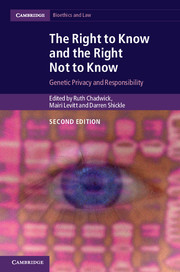Book contents
- Frontmatter
- Contents
- List of contributors
- Acknowledgements
- Introduction
- Part I Philosophical and legal issues
- Part II Issues in genetics
- Part III Emerging issues
- 9 The right to know and the right not to know in the era of neoliberal biopolitics and bioeconomy
- 10 The parental love argument against ‘designing’ babies: the harm in knowing that one has been selected or enhanced
- 11 The press and the public interest
- 12 The inescapability of knowing and inability to not know in the digital society
- 13 The food we eat: the right to be informed and the duty to inform
- Index
- References
11 - The press and the public interest
Published online by Cambridge University Press: 05 September 2014
- Frontmatter
- Contents
- List of contributors
- Acknowledgements
- Introduction
- Part I Philosophical and legal issues
- Part II Issues in genetics
- Part III Emerging issues
- 9 The right to know and the right not to know in the era of neoliberal biopolitics and bioeconomy
- 10 The parental love argument against ‘designing’ babies: the harm in knowing that one has been selected or enhanced
- 11 The press and the public interest
- 12 The inescapability of knowing and inability to not know in the digital society
- 13 The food we eat: the right to be informed and the duty to inform
- Index
- References
Summary
Journalistic mass media are an important and for some people the only source of information about biomedical and scientific developments. How the media treat these topics hence frames the public debate about the ethical and legal issues regarding medical applications and technologies. However, the inter-relationships and inter-dependence of scientists and researchers, journalists and the public are more complex and require deeper investigation. What may appear as objective reporting of facts is often more subjective and hence prone to socio-cultural and political framings of the debates. In this chapter an overview is provided on how research on science and technology in the media and public opinion can contribute to a better understanding of public debates about biotechnology.
Genetics and biotechnology started to become a controversial topic in public debates and media coverage from the 1990s onwards. Accordingly, a lot of research on news coverage and public opinion related to biotechnology has been done during the emergence and controversy phase of this technology (e.g. Gaskell and Bauer 2001; Bauer and Gaskell 2002). Genetic manipulation and biotechnology became a topic of mass interest in the mid-1990s in Europe, after genetically modified soy beans were introduced in Europe and the birth of the first cloned mammal, Dolly the sheep (see, e.g., Holliman 2004) was announced in February 1997 (Hampel 2012). It was also around that time that the debate around biotechnology settled into the distinction between agri-food (green) and bio-medical (red) biotechnology. This distinction had consequences for how the different technologies were portrayed in the mass media and also for how they were perceived by the public (Bauer 2005).
Information
- Type
- Chapter
- Information
- The Right to Know and the Right Not to KnowGenetic Privacy and Responsibility, pp. 165 - 179Publisher: Cambridge University PressPrint publication year: 2014
References
Accessibility standard: Unknown
Why this information is here
This section outlines the accessibility features of this content - including support for screen readers, full keyboard navigation and high-contrast display options. This may not be relevant for you.Accessibility Information
- 2
- Cited by
